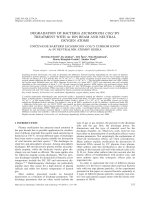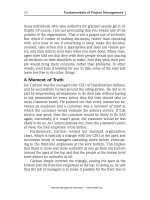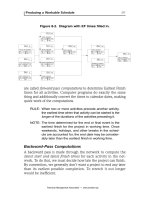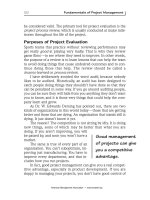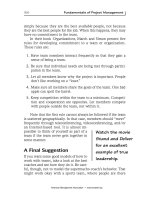Fundamentals of Applied Electromagnetics 6e by Fawwaz T. Ulaby, Eric Michielssen, and Umberto Ravaioli
Bạn đang xem bản rút gọn của tài liệu. Xem và tải ngay bản đầy đủ của tài liệu tại đây (13.67 MB, 290 trang )
Fundamentals of Applied Electromagnetics 6e
by
Fawwaz T. Ulaby, Eric Michielssen, and Umberto Ravaioli
Figures
Fawwaz T. Ulaby, Eric Michielssen, and Umberto Ravaioli, Fundamentals of Applied Electromagnetics
c 2010 Prentice Hall
Chapters
Chapter 1 Introduction: Waves and Phasors
Chapter 2 Transmission Lines
Chapter 3 Vector Analysis
Chapter 4 Electrostatics
Chapter 5 Magnetostatics
Chapter 6 Maxwell’s Equations for Time-Varying Fields
Chapter 7 Plane-Wave Propagation
Chapter 8 Wave Reflection and Transmission
Chapter 9 Radiation and Antennas
Chapter 10 Satellite Communication Systems and Radar Sensors
Fawwaz T. Ulaby, Eric Michielssen, and Umberto Ravaioli, Fundamentals of Applied Electromagnetics
c 2010 Prentice Hall
Chapter 1 Figures
Figure 1-1 2-D LCD array.
Figure 1-2 Electromagnetics is at the heart of numerous systems and applications.
Figure 1-3 Gravitational forces between two masses.
Figure 1-4 Gravitational field ψ 1 induced by a mass m1 .
Figure 1-5 Electric forces on two positive point charges in free space.
Figure 1-6 Electric field E due to charge q.
Figure 1-7 Polarization of the atoms of a dielectric material by a positive charge q.
Figure 1-8 Pattern of magnetic field lines around a bar magnet.
Figure 1-9 The magnetic field induced by a steady current flowing in the z-direction.
Figure 1-10 A one-dimensional wave traveling on a string.
Figure 1-11 Examples of two-dimensional and three-dimensional waves.
Figure 1-12 Plots of y(x,t) = A cos
2πt
T
as a function of (a) x at t = 0 and (b) t at x = 0.
− 2πx
λ
Figure 1-13 Plots of y(x,t) = A cos
2πt
T
− 2πx
λ
Figure 1-14 Plots of y(0,t) = A cos [(2πt/T ) + φ0 ] for three different values of the reference
phase φ0 .
Figure 1-15 Plot of y(x) = (10e−0.2x cos πx) meters.
Figure 1-16 The electromagnetic spectrum.
Figure 1-17 Individual bands of the radio spectrum and their primary allocations in the US.
Figure 1-18 Relation between rectangular and polar representations of a complex number.
Figure 1-19 Complex numbers V and I in the complex plane.
Figure 1-20 RC circuit connected to a voltage source.
Figure 1-21 RL circuit.
Fawwaz T. Ulaby, Eric Michielssen, and Umberto Ravaioli, Fundamentals of Applied Electromagnetics
c 2010 Prentice Hall
Figure 1-1: 2-D LCD array.
Fawwaz T. Ulaby, Eric Michielssen, and Umberto Ravaioli, Fundamentals of Applied Electromagnetics
c 2010 Prentice Hall
Figure 1-2: Electromagnetics is at the heart of numerous systems and applications.
Fawwaz T. Ulaby, Eric Michielssen, and Umberto Ravaioli, Fundamentals of Applied Electromagnetics
c 2010 Prentice Hall
Figure 1-3: Gravitational forces between two masses.
Fawwaz T. Ulaby, Eric Michielssen, and Umberto Ravaioli, Fundamentals of Applied Electromagnetics
c 2010 Prentice Hall
Figure 1-4: Gravitational field ψ 1 induced by a mass m1 .
Fawwaz T. Ulaby, Eric Michielssen, and Umberto Ravaioli, Fundamentals of Applied Electromagnetics
c 2010 Prentice Hall
Figure 1-5: Electric forces on two positive point charges in free space.
Fawwaz T. Ulaby, Eric Michielssen, and Umberto Ravaioli, Fundamentals of Applied Electromagnetics
c 2010 Prentice Hall
Figure 1-6: Electric field E due to charge q.
Fawwaz T. Ulaby, Eric Michielssen, and Umberto Ravaioli, Fundamentals of Applied Electromagnetics
c 2010 Prentice Hall
Figure 1-7: Polarization of the atoms of a dielectric material by a positive charge q.
Fawwaz T. Ulaby, Eric Michielssen, and Umberto Ravaioli, Fundamentals of Applied Electromagnetics
c 2010 Prentice Hall
Figure 1-8: Pattern of magnetic field lines around a bar magnet.
Fawwaz T. Ulaby, Eric Michielssen, and Umberto Ravaioli, Fundamentals of Applied Electromagnetics
c 2010 Prentice Hall
Figure 1-9: The magnetic field induced by a steady current flowing in the z-direction.
Fawwaz T. Ulaby, Eric Michielssen, and Umberto Ravaioli, Fundamentals of Applied Electromagnetics
c 2010 Prentice Hall
Figure 1-10: A one-dimensional wave traveling on a string.
Fawwaz T. Ulaby, Eric Michielssen, and Umberto Ravaioli, Fundamentals of Applied Electromagnetics
c 2010 Prentice Hall
Figure 1-11: Examples of two-dimensional and three-dimensional waves: (a) circular waves on a pond, (b) a plane light wave exciting
a cylindrical light wave through the use of a long narrow slit in an opaque screen, and (c) a sliced section of a spherical wave.
Fawwaz T. Ulaby, Eric Michielssen, and Umberto Ravaioli, Fundamentals of Applied Electromagnetics
c 2010 Prentice Hall
Figure 1-12: Plots of y(x,t) = A cos
2πt
T
− 2πx
as a function of (a) x at t = 0 and (b) t at x = 0.
λ
Fawwaz T. Ulaby, Eric Michielssen, and Umberto Ravaioli, Fundamentals of Applied Electromagnetics
c 2010 Prentice Hall
2πx
Figure 1-13: Plots of y(x,t) = A cos 2πt
as a function of x at (a) t = 0, (b) t = T /4, and (c) t = T /2. Note that the wave moves
T − λ
in the +x-direction with a velocity up = λ /T .
Fawwaz T. Ulaby, Eric Michielssen, and Umberto Ravaioli, Fundamentals of Applied Electromagnetics
c 2010 Prentice Hall
Figure 1-14: Plots of y(0,t) = A cos [(2πt/T ) + φ0 ] for three different values of the reference phase φ0 .
Fawwaz T. Ulaby, Eric Michielssen, and Umberto Ravaioli, Fundamentals of Applied Electromagnetics
c 2010 Prentice Hall
Figure 1-15: Plot of y(x) = (10e−0.2x cos πx) meters. Note that the envelope is bounded between the curve given by 10e−0.2x and its
mirror image.
Fawwaz T. Ulaby, Eric Michielssen, and Umberto Ravaioli, Fundamentals of Applied Electromagnetics
c 2010 Prentice Hall
Figure 1-16: The electromagnetic spectrum.
Fawwaz T. Ulaby, Eric Michielssen, and Umberto Ravaioli, Fundamentals of Applied Electromagnetics
c 2010 Prentice Hall
Figure 1-17: Individual bands of the radio spectrum and their primary allocations in the US. [See expandable version on CD.]
Fawwaz T. Ulaby, Eric Michielssen, and Umberto Ravaioli, Fundamentals of Applied Electromagnetics
c 2010 Prentice Hall
Figure 1-18: Relation between rectangular and polar representations of a complex number z = x + jy = |z|e jθ .
Fawwaz T. Ulaby, Eric Michielssen, and Umberto Ravaioli, Fundamentals of Applied Electromagnetics
c 2010 Prentice Hall
Figure 1-19: Complex numbers V and I in the complex plane (Example 1-3).
Fawwaz T. Ulaby, Eric Michielssen, and Umberto Ravaioli, Fundamentals of Applied Electromagnetics
c 2010 Prentice Hall
Figure 1-20: RC circuit connected to a voltage source υs (t).
Fawwaz T. Ulaby, Eric Michielssen, and Umberto Ravaioli, Fundamentals of Applied Electromagnetics
c 2010 Prentice Hall
Figure 1-21: RL circuit (Example 1-4).
Fawwaz T. Ulaby, Eric Michielssen, and Umberto Ravaioli, Fundamentals of Applied Electromagnetics
c 2010 Prentice Hall
Chapter 2 Figures
Figure 2-1 A transmission line is a two-port network connecting a generator circuit at the
sending end to a load at the receiving end.
Figure 2-2 Generator connected to an RC circuit through a transmission line of length l.
Figure 2-3 A dispersionless line does not distort signals passing through it regardless of
its length, whereas a dispersive line distorts the shape of the input pulses because the
different frequency components propagate at different velocities. The degree of distortion
is proportional to the length of the dispersive line.
Figure 2-4 A few examples of transverse electromagnetic (TEM) and higher-order
transmission lines.
Figure 2-5 In a coaxial line, the electric field is in the radial direction between the inner and
outer conductors, and the magnetic field forms circles around the inner conductor.
Figure 2-6 Regardless of its cross-sectional shape, a TEM transmission line is represented by
the parallel-wire configuration shown in (a). To obtain equations relating voltages and
currents, the line is subdivided into small differential sections (b), each of which is then
represented by an equivalent circuit (c).
Figure 2-7 Cross-section of a coaxial line with inner conductor of radius a and outer conductor
of radius b. The conductors have magnetic permeability µc , and conductivity σc , and
the spacing material between the conductors has permittivity ε, permeability µ, and
conductivity σ .
Figure 2-8 Equivalent circuit of a two-conductor transmission line of differential length ∆z.
Figure 2-9 In general, a transmission line can support two traveling waves, an incident wave
(with voltage and current amplitudes (V0+ , I0+ )) traveling along the +z-direction (towards
the load) and a reflected wave (with (V0− , I0− )) traveling along the −z-direction (towards
the source).
Figure 2-10 Microstrip line: (a) longitudinal view, (b) cross-sectional view, and (c) circuit
example. (Courtesy of Prof. Gabriel Rebeiz, U. California at San Diego.)
Figure 2-11 Plots of Z0 as a function of s for various types of dielectric materials.
Fawwaz T. Ulaby, Eric Michielssen, and Umberto Ravaioli, Fundamentals of Applied Electromagnetics
c 2010 Prentice Hall


